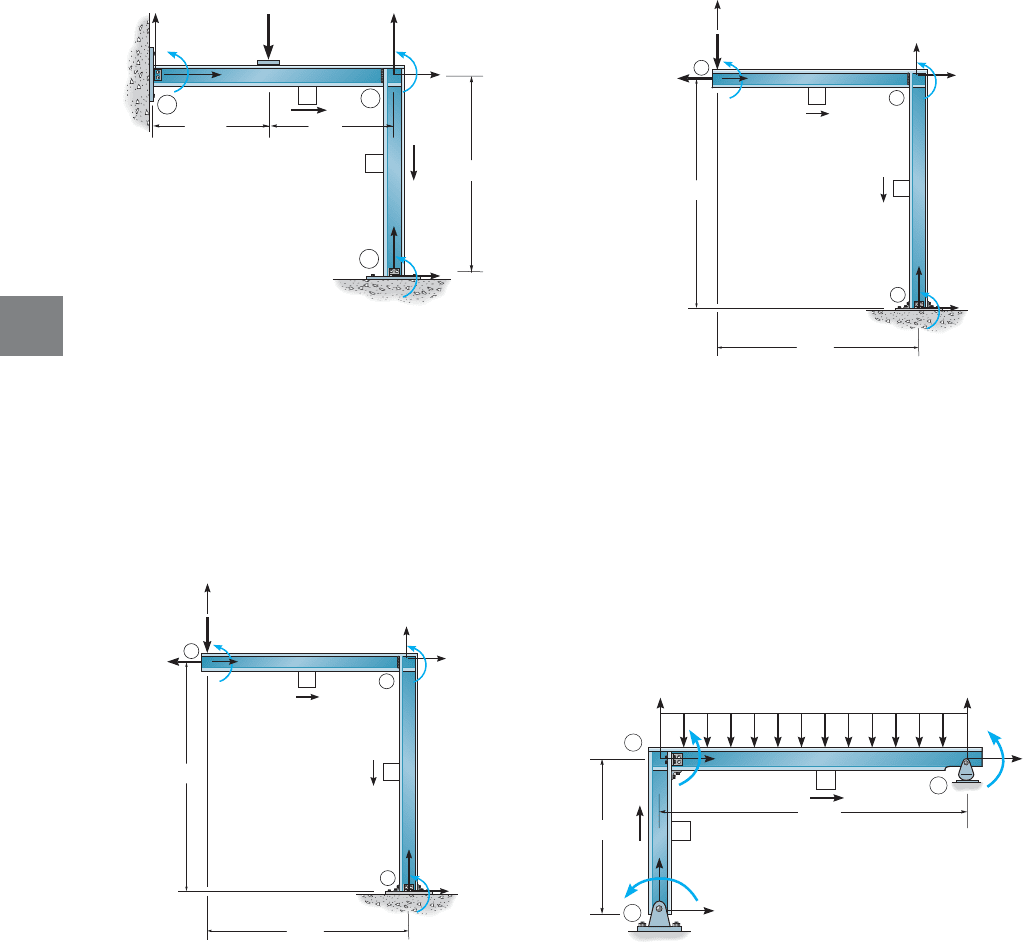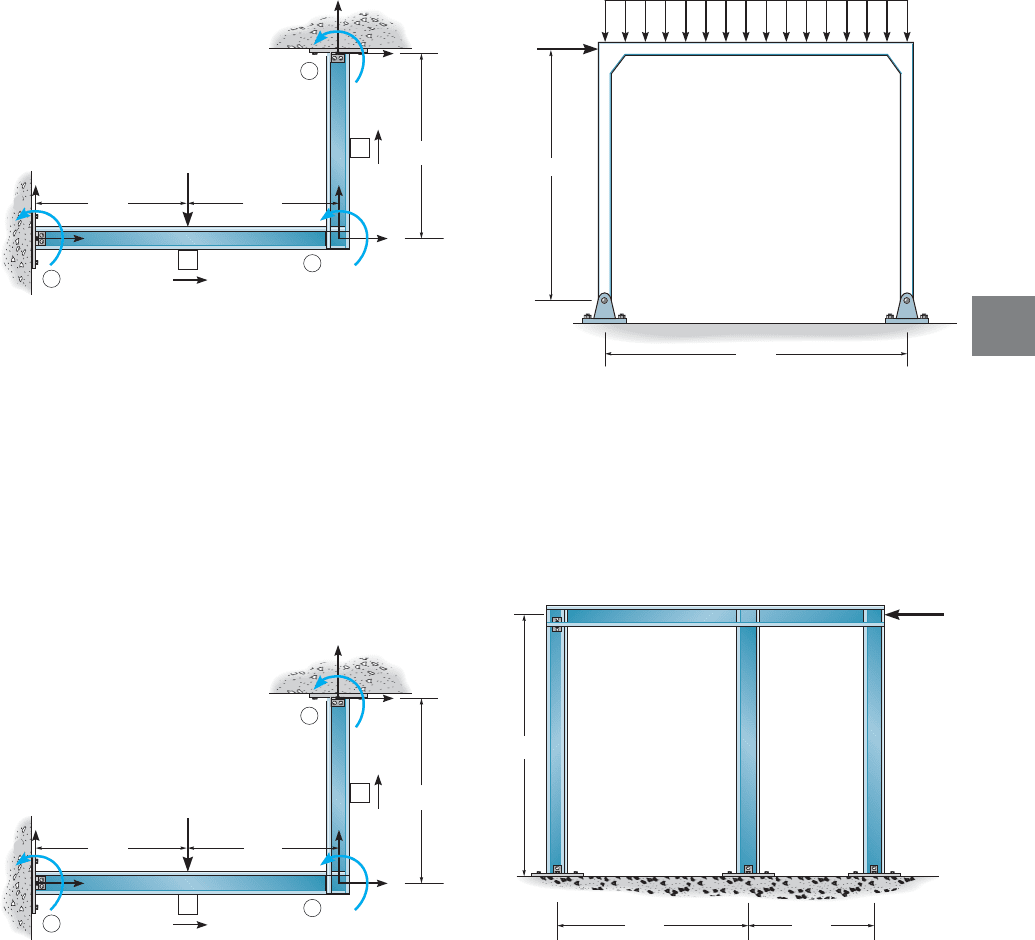Hibbeler R.C. Structural Analysis
Подождите немного. Документ загружается.


610 CHAPTER 16 PLANE FRAME ANALYSIS U SING THE STIFFNESS METHOD
16
16–9. Determine the stiffness matrix K for the frame.Take
, , for each member.
16–10. Determine the support reactions at
① and ➂. Take
, for each member.A = 10 in
2
I = 300 in
4
E = 29110
3
2 ksi,
A = 10 in
2
I = 300 in
4
E = 29110
3
2 ksi
10 ft
20 ft
2
1
3
2
7
1
4
6
9
8
5
2
1
3
2 k/ft
Probs. 16–9/16–10
16–7. Determine the structure stiffness matrix K for
the frame. Take , ,
for each member.
A = 20 in
2
I = 650 in
4
E = 29110
3
2 ksi
Prob. 16–7
2
1
6
5
4
2
1
3
2
1
6 k
4 k
3
9
8
7
12 ft
10 ft
*16–8. Determine the components of displacement at ①.
Take , , for each
member.
A = 20 in
2
I = 650 in
4
E = 29110
3
2 ksi
Prob. 16–8
2
1
6
5
4
2
1
3
2
1
6 k
4 k
3
9
8
7
12 ft
10 ft
Prob. 16–6
9
1
2
3
1
2
2
1
3
6
4
4 m
2 m
2 m
60 kN
5
8
7
16–6. Determine the support reactions at pins ① and ➂.
Take , ,
for each member.
A = 15110
3
2 mm
2
I = 350110
6
2 mm
4
E = 200 GPa

16
16.4 A
PPLICATION OF THE STIFFNESS METHOD FOR FRAME ANALYSIS 611
16–13. Use a computer program to determine the reactions
on the frame. AE and EI are constant.
16–11. Determine the structure stiffness matrix K for the
frame. Take , , for
each member.
A = 20 in
2
I = 700 in
4
E = 29110
3
2 ksi
16–14. Use a computer program to determine the reactions
on the frame. Assume A, B, D, and F are pins. AE and EI
are constant.
1
2
9
8
3
2
1
3
16 ft
20 k
12 ft12 ft
1
2
4
7
6
5
A
B
C
E
F
6 m
4 m
8 m
8 kN
D
A
D
15 k
B
C
20 ft
24 ft
1.5 k/ft
Prob. 16–11
*16–12. Determine the support reactions at the pins
①
and ➂. Take , , for
each member.
A = 20 in
2
I = 700 in
4
E = 29110
3
2 ksi
1
2
9
8
3
2
1
3
16 ft
20 k
12 ft12 ft
1
2
4
7
6
5
Prob. 16–12
Prob. 16–13
Prob. 16–14

612
Matrix Algebra for
Structural Analysis
APPENDIX
A
A.1 Basic Definitions and Types
of Matrices
With the accessibility of desk top computers, application of matrix algebra
for the analysis of structures has become widespread. Matrix algebra
provides an appropriate tool for this analysis, since it is relatively easy to
formulate the solution in a concise form and then perform the actual
matrix manipulations using a computer. For this reason it is important
that the structural engineer be familiar with the fundamental operations
of this type of mathematics.
Matrix. A matrix is a rectangular arrangement of numbers having m
rows and n columns.The numbers, which are called elements, are assembled
within brackets. For example, the A matrix is written as:
Such a matrix is said to have an order of (m by n). Notice that the
first subscript for an element denotes its row position and the second
subscript denotes its column position. In general, then, is the element
located in the ith row and jth column.
Row Matrix. If the matrix consists only of elements in a single row,
it is called a row matrix. For example, a row matrix is written as
Here only a single subscript is used to denote an element, since the row
subscript is always understood to be equal to 1, that is,
and so on.
a
2
= a
12
,a
1
= a
11
,
A = [a
1
a
2
Á
a
n
]
1 * n
a
ij
m * n
A = D
a
11
a
12
Á
a
1n
a
21
a
22
Á
a
2n
o
a
m1
a
m2
Á
a
mn
T

Column Matrix. A matrix with elements stacked in a single column
is called a column matrix. The column matrix is
Here the subscript notation symbolizes and so on.
Square Matrix. When the number of rows in a matrix equals the
number of columns, the matrix is referred to as a square matrix. An
square matrix would be
Diagonal Matrix. When all the elements of a square matrix are
zero except along the main diagonal, running down from left to right, the
matrix is called a diagonal matrix. For example,
Unit or Identity Matrix. The unit or identity matrix is a diagonal
matrix with all the diagonal elements equal to unity. For example,
Symmetric Matrix. A square matrix is symmetric provided
For example,
A = C
352
5 -14
248
S
a
ij
= a
ji
.
I = C
100
010
001
S
A = C
a
11
00
0 a
22
0
00a
33
S
A = D
a
11
a
12
Á
a
1n
a
21
a
22
Á
a
2n
o
a
n1
a
n2
Á
a
nn
T
n * n
a
2
= a
21
,a
1
= a
11
,
A = D
a
1
a
2
o
a
m
T
m * 1
A.1 BASIC DEFINITIONS AND TYPES OF MATRICES 613
A

614 APPENDIX AMATRIX ALGEBRA FOR S TRUCTURAL A NALYSIS
A
A.2 Matrix Operations
Equality of Matrices. Matrices A and B are said to be equal if
they are of the same order and each of their corresponding elements are
equal, that is, For example, if
then
Addition and Subtraction of Matrices. Two matrices can be
added together or subtracted from one another if they are of the same
order. The result is obtained by adding or subtracting the corresponding
elements. For example, if
then
Multiplication by a Scalar. When a matrix is multiplied by a
scalar, each element of the matrix is multiplied by the scalar. For
example, if
then
Matrix Multiplication. Two matrices A and B can be multiplied
together only if they are conformable. This condition is satisfied if the
number of columns in A equals the number of rows in B. For example, if
(A–1)
then AB can be determined since A has two columns and B has two rows.
Notice, however, that BA is not possible.Why?
A = c
a
11
a
12
a
21
a
22
d
B = c
b
11
b
12
b
13
b
21
b
22
b
23
d
kA = c
-24 -6
-36 12
d
A = c
41
6 -2
d
k =-6
A + B = c
115
33
d
A - B = c
11 -1
1 -5
d
A = c
67
2 -1
d
B = c
-58
14
d
A = B.
A = c
26
4 -3
d
B = c
26
4 -3
d
a
ij
= b
ij
.

A.2 MATRIX OPERATIONS 615
If matrix A having an order of is multiplied by matrix B
having an order of it will yield a matrix C having an order of
that is,
The elements of matrix C are found using the elements of A and
of B as follows:
(A–2)
The methodology of this formula can be explained by a few simple
examples. Consider
By inspection, the product is possible since the matrices are
conformable, that is, A has three columns and B has three rows. By
Eq. A–2, the multiplication will yield matrix C having two rows and one
column. The results are obtained as follows:
Multiply the elements in the first row of A by corresponding elements
in the column of B and add the results; that is,
Multiply the elements in the second row of A by corresponding
elements in the column of B and add the results; that is,
Thus
C = c
49
41
d
c
21
= c
2
=-1122+ 6162+ 1172= 41
c
21
:
c
11
= c
1
= 2122+ 4162+ 3172= 49
c
11
:
C = AB
A = c
243
-161
d B = C
2
6
7
S
c
ij
=
a
n
k = 1
a
ik
b
kj
b
ij
a
ij
1m * n21n * q21m * q2
AB = C
1m * q2,
1n * q2
1m * n2
A

616 APPENDIX AMATRIX ALGEBRA FOR S TRUCTURAL A NALYSIS
A
As a second example, consider
Here again the product can be found since A has two columns
and B has two rows. The resulting matrix C will have three rows and two
columns. The elements are obtained as follows:
The scheme for multiplication follows application of Eq. A–2. Thus,
Notice also that BA does not exist, since written in this manner the
matrices are nonconformable.
The following rules apply to matrix multiplication.
1. In general the product of two matrices is not commutative:
(A–3)
2. The distributive law is valid:
(A–4)
3. The associative law is valid:
(A–5)
Transposed Matrix. A matrix may be transposed by interchanging
its rows and columns. For example, if
A = C
a
11
a
12
a
13
a
21
a
22
a
23
a
31
a
32
a
33
S
B = [b
1
b
2
b
3
]
A1BC2= 1AB2C
A1B + C2= AB + AC
AB Z BA
C = C
147
532
-28 18
S
c
32
=-2172+ 8142= 18
1third row of A times second column of B2
c
31
=-2122+ 81-32=-28
1third row of A times first column of B2
c
22
= 4172+ 1142= 32
1second row of A times second column of B2
c
21
= 4122+ 11-32= 5
1second row of A times first column of B2
c
12
= 5172+ 3142= 47
1first row of A times second column of B2
c
11
= 5122+ 31-32= 1
1first row of A times first column of B2
C = AB
A = C
53
41
-28
S
B = c
27
-34
d

A.2 MATRIX OPERATIONS 617
Then
Notice that AB is nonconformable and so the product does not exist.
(A has three columns and B has one row.) Alternatively, multiplication
is possible since here the matrices are conformable (A has three
columns and has three rows). The following properties for transposed
matrices hold:
(A–6)
(A–7)
(A–8)
This last identity will be illustrated by example. If
Then, by Eq. A–8,
Matrix Partitioning. A matrix can be subdivided into submatrices
by partitioning. For example,
Here the submatrices are
A
21
= c
a
21
a
31
d A
22
= c
a
22
a
23
a
24
a
32
a
33
a
34
d
A
11
= [a
11
] A
12
= [a
12
a
13
a
14
]
A = C
a
11
a
12
a
13
a
14
a
21
a
22
a
23
a
24
a
31
a
32
a
33
a
34
S= c
A
11
A
12
A
21
A
22
d
c
28 -2
28 -12
d = c
28 -2
28 -12
d
ac
28 28
-2 -12
db
T
= c
28 -2
28 -12
d
ac
62
1 -3
dc
43
25
db
T
= c
42
35
dc
61
2 -3
d
A = c
62
1 -3
d B = c
43
25
d
1AB2
T
= B
T
A
T
1kA2
T
= kA
T
1A + B2
T
= A
T
+ B
T
B
T
AB
T
A
T
= C
a
11
a
21
a
31
a
12
a
22
a
32
a
13
a
23
a
33
S B
T
= C
b
1
b
2
b
3
S
A

618 APPENDIX AMATRIX ALGEBRA FOR S TRUCTURAL A NALYSIS
A
The rules of matrix algebra apply to partitioned matrices provided the
partitioning is conformable. For example, corresponding submatrices of A
and B can be added or subtracted provided they have an equal number of
rows and columns. Likewise, matrix multiplication is possible provided
the respective number of columns and rows of both A and B and their
submatrices are equal. For instance, if
then the product AB exists, since the number of columns of A equals the
number of rows of B (three). Likewise, the partitioned matrices are
conformable for multiplication since A is partitioned into two columns
and B is partitioned into two rows, that is,
Multiplication of the submatrices yields
A.3 Determinants
In the next section we will discuss how to invert a matrix. Since this
operation requires an evaluation of the determinant of the matrix, we will
now discuss some of the basic properties of determinants.
A determinant is a square array of numbers enclosed within vertical
bars. For example, an nth-order determinant, having n rows and n
columns, is
(A–9)
ƒ
A
ƒ
=
4
a
11
a
12
Á
a
1n
a
21
a
22
Á
a
2n
o
a
n1
a
n2
Á
a
nn
4
AB = D
c
8
-4
4
2
d + c
-7
-35
-4
-20
d
[12 18] + [56 32]
T= C
10
-39 -18
68 50
S
A
22
B
21
= [8][7 4] = [56 32]
A
21
B
11
= [6 3]c
2 -1
08
d = [12 18]
A
12
B
21
= c
-1
-5
d[7 4] = cc
-7 -4
-35 -20
d
A
11
B
11
= c
41
-20
dc
2 -1
08
d = c
84
-42
d
AB = c
A
11
A
12
A
21
A
22
dc
B
11
B
21
d = c
A
11
B
11
+ A
12
B
21
A
21
B
11
+ A
22
B
21
d
A = C
41-1
-20-5
63 8
S B = C
2 -1
08
74
S

A.3 DETERMINANTS 619
Evaluation of this determinant leads to a single numerical value which
can be determined using Laplace’s expansion. This method makes use of
the determinant’s minors and cofactors. Specifically, each element of a
determinant of nth order has a minor which is a determinant of order
This determinant (minor) remains when the ith row and jth column
in which the element is contained is canceled out. If the minor is
multiplied by it is called the cofactor of and is denoted as
(A–10)
For example, consider the third-order determinant
The cofactors for the elements in the first row are
Laplace’s expansion for a determinant of order n, Eq. A–9, states that
the numerical value represented by the determinant is equal to the sum
of the products of the elements of any row or column and their respective
cofactors, i.e.,
or (A–11)
For application, it is seen that due to the cofactors the number D is defined
in terms of n determinants (cofactors) of order each. These
determinants can each be reevaluated using the same formula, whereby
one must then evaluate determinants of order and so
on.The process of evaluation continues until the remaining determinants
to be evaluated reduce to the second order, whereby the cofactors of the
elements are single elements of D. Consider, for example, the following
second-order determinant
We can evaluate D along the top row of elements, which yields
Or, for example, using the second column of elements, we have
D = 51-12
1 + 2
1-12+ 21-12
2 + 2
132= 11
D = 31-12
1 + 1
122+ 51-12
1 + 2
1-12= 11
D =
`
35
-12
`
1n - 22,1n - 12
n - 1
D = a
1j
C
1j
+ a
2j
C
2j
+
Á
+ a
nj
C
nj
1j = 1, 2, Á , or n2
D = a
i1
C
i1
+ a
i2
C
i2
+
Á
+ a
in
C
in
1i = 1, 2, Á , or n2
C
13
= 1-12
1 + 3
`
a
21
a
22
a
31
a
32
`
=
`
a
21
a
22
a
31
a
32
`
C
12
= 1-12
1 + 2
`
a
21
a
23
a
31
a
33
`
=-
`
a
21
a
23
a
31
a
33
`
C
11
= 1-12
1 + 1
`
a
22
a
23
a
32
a
33
`
=
`
a
22
a
23
a
32
a
33
`
3
a
11
a
12
a
13
a
21
a
22
a
23
a
31
a
32
a
33
3
C
ij
= 1-12
i + j
M
ij
a
ij
1-12
i + j
a
ij
n - 1.
M
ij
a
ij
A
